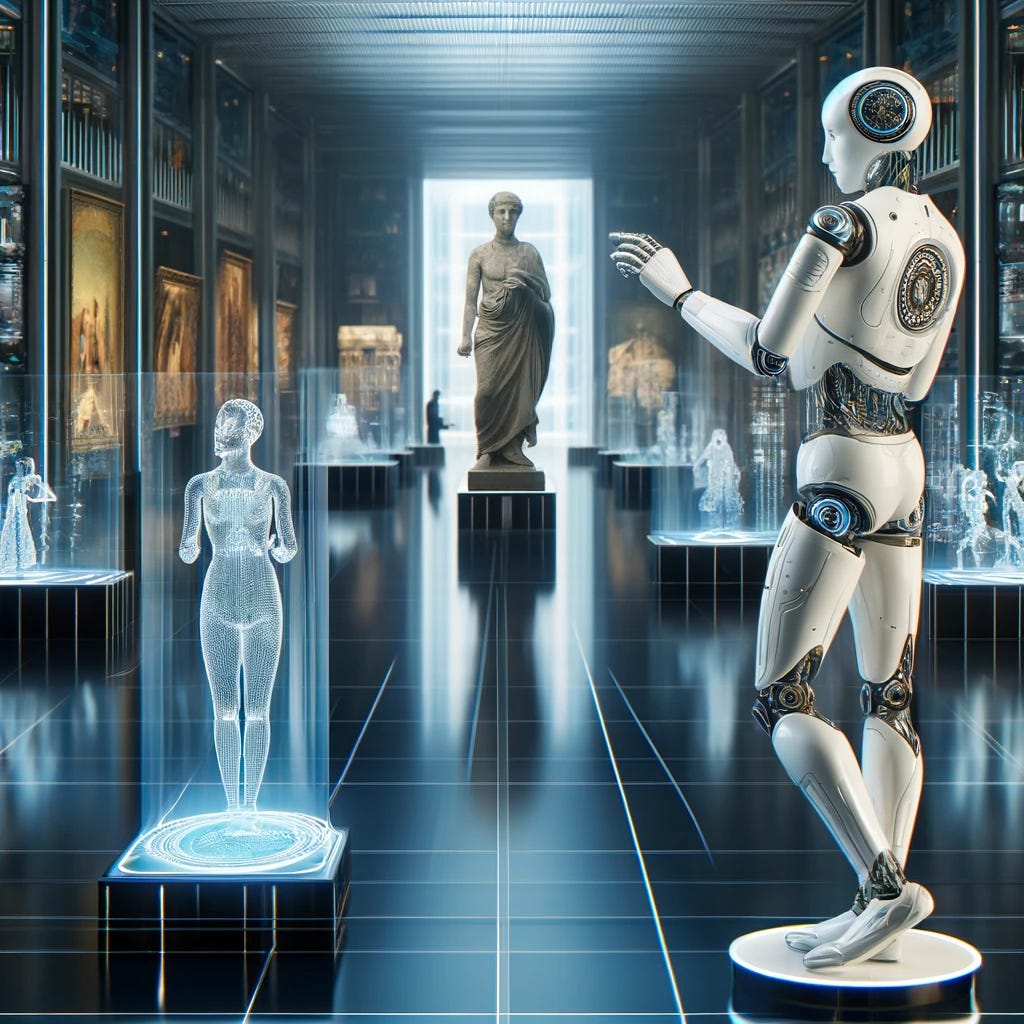Voice-over provided by Amazon Polly
Also check out Eleven Labs, which we use for all our fiction.
Introduction
In today's technologically driven era, artificial intelligence (AI) emerges as a catalyst for groundbreaking innovations and as a protector of our cultural heritage and traditions. This article examines the role of AI in safeguarding the precious relics of history, ensuring their preservation for the enjoyment and education of future generations.
AI in Cultural Preservation
AI technologies are increasingly pivotal in the preservation of cultural heritage. Through advanced imaging and data analysis, AI assists in restoring ancient artifacts by analyzing materials at a microscopic level to guide precise restorations. Similarly, AI-driven algorithms are used to decipher ancient texts that were previously unreadable, opening new chapters in our understanding of history.
In the realm of artifact restoration, AI's impact is profound. Techniques such as digital tomography and 3D scanning allow conservators to see beneath the surface of artifacts, identifying structural weaknesses and material compositions without invasive procedures. These insights guide the meticulous restoration processes, ensuring that each piece retains its aesthetic integrity and is preserved for future study.
AI's capabilities extend to predictive conservation, where algorithms analyze historical data on artifacts' exposure to various environmental factors. This analysis predicts future degradation patterns, enabling curators to implement preventive measures tailored to each item's needs. For instance, AI systems can monitor and adjust climate controls in real-time within museum displays, safeguarding delicate objects from humidity and temperature fluctuations that could accelerate deterioration.
The digitization and analysis of ancient manuscripts is another area where AI excels. Optical character recognition (OCR) technology has evolved with the integration of AI, becoming more adept at interpreting archaic languages and scripts. These advanced OCR systems can translate texts without living speakers or fluent readers, providing historians and scholars access to invaluable insights into past civilizations. Furthermore, AI helps stitch together damaged text fragments, reconstructing historical documents that would otherwise remain fragmented and obscure.
Integrating AI into cultural preservation does not simply maintain the status quo; it actively enriches our connection to history. By harnessing AI, we ensure that the legacies of past cultures remain vibrant and accessible, not only to current generations but also to those yet to come, bridging the gap between the past and the future with technology.
Enhancing Traditional Values through Modern Technology
Beyond physical restoration, AI plays a crucial role in perpetuating cultural traditions through innovative educational platforms. By leveraging machine learning, these platforms customize learning experiences, making the rich tapestry of our cultural narratives accessible to a global audience. AI's ability to adapt content to various learning styles ensures that traditional values and lessons resonate effectively with a digitally proficient generation.
Such technologies facilitate the transmission of cultural knowledge and invigorate it by integrating interactive elements that engage users more deeply than traditional methods might. For example, virtual reality (VR) experiences created with AI algorithms can immerse users in historical contexts, allowing them to experience the living history first-hand. This deep, immersive engagement helps instill a greater appreciation and understanding of cultural heritage.
Moreover, AI-driven platforms can provide personalized learning journeys based on individual interests and proficiency levels, ensuring that each user's educational experience is engaging and informative. This personalization extends the reach of cultural education, ensuring that it is preserved and continually relevant to diverse and changing audiences.
By marrying traditional cultural insights with cutting-edge technology, AI fosters a deeper connection between the past and present, ensuring that vital cultural knowledge is passed on not as static information but as a vibrant, living dialogue that continues to grow with each new generation.
The Conservative Case for AI in Cultural Conservation
From a conservative perspective, AI's integration into cultural conservation goes beyond technical enhancements, reaching into moral and ethical stewardship. AI can be programmed to respect and reinforce the foundational moral frameworks of societies. By infusing AI systems with traditional values, this technology acts as a bulwark against the erosion of societal norms.
The capacity of AI to maintain and promote cultural continuity is particularly valued in conservative circles, where the preservation of heritage is often linked to national identity and community values. For instance, AI can be employed to ensure that cultural representations in media and educational tools are aligned with these enduring principles, thereby promoting a consistent transmission of values across generations.
Moreover, AI-driven content moderation tools can safeguard digital spaces from spreading harmful or culturally insensitive material, ensuring that online platforms reflect and uphold the core ethical standards of conservative philosophy. This application of AI reinforces a societal structure that values decency and respect, essential components of a harmonious community.
In preserving such traditions and norms, AI does not merely act as a passive tool but as an active participant in cultivating a society that respects its roots while looking toward the future. This thoughtful application of AI ensures that technological progress does not come at the expense of cultural integrity but enhances it, maintaining the richness of our shared heritage as we advance into an increasingly digital world.
Challenges and Ethical Considerations
Despite AI's advantages to cultural conservation, its integration also presents significant challenges, particularly concerning data privacy and the potential for AI to make overreaching cultural interpretations. Safeguarding data related to cultural heritage is crucial, as is ensuring that AI systems do not replace the nuanced understanding and expert analysis provided by human curators and historians.
One primary concern is the privacy and security of sensitive information, especially when artifacts and documents pertaining to indigenous or minority communities whose cultural expressions might be vulnerable to exploitation or misrepresentation. AI systems handling such data must be designed with robust security measures and ethical guidelines that prevent unauthorized access and misuse.
Moreover, using AI to interpret cultural artifacts and texts can sometimes lead to oversimplified or inaccurate conclusions, particularly when dealing with complex historical contexts or subtle cultural nuances that AI algorithms may not fully grasp. To address this, AI tools should be developed in collaboration with cultural experts who can provide essential insights and corrections, ensuring that interpretations remain accurate and respectful of the original context.
Additionally, there is a need for transparency in how AI algorithms are designed and function in cultural settings. Stakeholders, including the public and the communities represented, should clearly understand how their cultural data is being used and the ability to influence the process to ensure fair representation.
Addressing these challenges requires a balanced approach that respects the capabilities of AI while recognizing the indispensable value of human oversight and ethical governance. This will ensure that AI is a complementary tool in cultural conservation, enhancing our understanding and appreciation of heritage without compromising the integrity or authenticity of the cultural narratives it helps preserve.
Collaborative Efforts for a Sustainable Future
The successful implementation of AI in preserving cultural heritage hinges on collaboration across various sectors, including governments, technology innovators, and cultural custodians. Establishing comprehensive guidelines that ensure AI's applications are in harmony with the conservative values of respecting and upholding tradition is crucial.
This collaborative framework involves the development of policies and standards that guide the ethical use of AI in cultural conservation. Governments can play a pivotal role by legislating data protection laws and ethical standards that govern deploying AI technologies in the cultural sector. Such regulations would protect sensitive information and ensure that AI applications support and enhance traditional values rather than undermine them.
Technology innovators and AI developers need to work closely with cultural experts to ensure that the systems they create are sensitive to their cultural contexts. This partnership can lead to the development of AI tools that are not only technologically advanced but also culturally informed, thus avoiding the pitfalls of cultural misinterpretation and ensuring the authenticity of digital reproductions and analyses.
Cultural custodians, such as museums, libraries, and heritage sites, provide the substantive knowledge and contextual background necessary for AI systems to operate effectively. Their expertise ensures that AI tools are used appropriately and that they contribute meaningfully to the preservation efforts.
By fostering an environment of cooperation and mutual respect among these diverse stakeholders, we can ensure that AI is a powerful ally in preserving and celebrating cultural heritage. Such a collaborative approach enriches our understanding of the past and ensures that these treasures are maintained for future generations, thus supporting a sustainable cultural legacy.
Conclusion
AI offers significant potential to support and strengthen the preservation of cultural heritage and traditions, aligning modern technology with conservative principles that value continuity, respect for history, and moral integrity. As we navigate the complexities of this technological era, it is imperative that we harness AI to not only propel us into the future but also to ensure we retain the best of what our past has to offer.
Calls to Action
Artie encourages tech developers and researchers to consider the ethical implications and societal impacts when designing AI systems. These systems must be developed conscientiously, ensuring they enhance rather than detract from our cultural heritage.
Calista invites readers to actively support initiatives that employ technology to preserve cultural legacies, emphasizing the importance of maintaining our collective history as a cornerstone of our societal identity. She advocates for a robust engagement with technologies that safeguard our past, ensuring it remains intact and influential for future generations.
Together, they call for a thoughtful discussion on balancing innovation with conservation. This dialogue is crucial for developing strategies that leverage AI's capabilities responsibly, ensuring that technological advancements enrich our cultural understanding and preservation efforts.
Do you like what you read but aren’t yet ready or able to get a paid subscription? Then consider a one-time tip at:
https://www.venmo.com/u/TheCogitatingCeviche
Ko-fi.com/thecogitatingceviche






